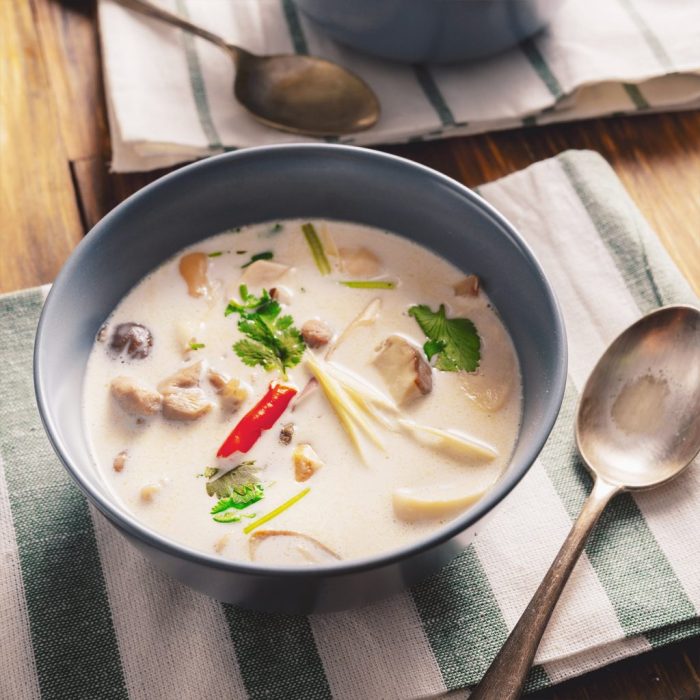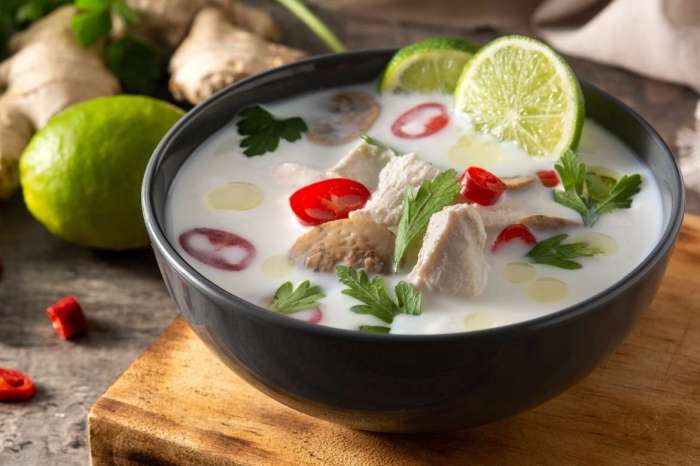Tom Ka Gai Soup: Ingredient Variations
Tom ka gai soup recipe – The delicate balance of flavors in Tom Ka Gai soup hinges significantly on the ingredients used. Variations in these components can drastically alter the soup’s overall taste and texture. This section explores the impact of different ingredients and offers substitution options.
Galangal, Lemongrass, and Kaffir Lime Leaf Variations
The aromatic trio of galangal, lemongrass, and kaffir lime leaves forms the heart of Tom Ka Gai’s distinctive flavor profile. The specific variety and quality of each significantly impact the final taste.
Different types of galangal offer varying levels of pungency and bitterness. Younger galangal tends to be more delicate, while older rhizomes possess a stronger, more intense flavor. Similarly, lemongrass stalks vary in their intensity; younger stalks are milder, while older ones are more assertive. Kaffir lime leaves also vary in their aromatic intensity, with fresher leaves offering a more vibrant citrusy aroma.
Using a combination of young and old galangal can provide a balanced flavor profile, combining the subtle sweetness of young galangal with the earthier notes of older rhizomes. Similarly, a blend of tender and mature lemongrass stalks allows for a nuanced flavor profile.
Coconut Milk Variations
The type of coconut milk used significantly influences the soup’s richness and texture. Coconut milk from different regions varies in its fat content and sweetness. Thai coconut milk, for example, often provides a richer, creamier texture compared to other varieties.
Tom Kha Gai soup, with its fragrant lemongrass and coconut milk, offers a delightful contrast to heartier soups. If you’re looking for a different kind of comforting warmth, you might enjoy exploring a completely different flavor profile with a recipe for white bean soup , which offers a robust and earthy alternative. Returning to Tom Kha Gai, remember to adjust the chili for your preferred spice level – a key element in achieving the perfect balance of flavors.
| Coconut Milk Origin | Fat Content | Sweetness | Impact on Soup |
|---|---|---|---|
| Thailand | High | Moderate | Creamy, rich texture; balanced sweetness |
| Philippines | Medium | Slightly higher | Creamy, less rich; slightly sweeter |
| Indonesia | Variable | Variable | Texture and sweetness vary depending on brand and processing |
Chicken Breast vs. Chicken Thighs
| Chicken Cut | Taste | Texture |
|---|---|---|
| Chicken Breast | Leaner, milder flavor | Firmer, less tender |
| Chicken Thighs | Rich, more savory flavor | More tender, succulent |
Tom Ka Gai Soup: Cooking Methods and Techniques
Mastering the art of Tom Ka Gai involves understanding the nuances of infusing aromatics and achieving the desired creamy texture without over-thickening the soup. This section details both traditional stovetop and slow cooker methods.
Traditional Stovetop Method
- Infuse the aromatics: Gently simmer galangal, lemongrass, and kaffir lime leaves in coconut milk for about 10-15 minutes to extract their full flavor. This step is crucial for developing the soup’s signature aroma.
- Add chicken and broth: Add chicken pieces and chicken broth to the infused coconut milk. Bring to a simmer and cook until the chicken is cooked through.
- Season and adjust: Add fish sauce, lime juice, and sugar to taste. Adjust the seasoning according to your preference. A pinch of salt can enhance the overall flavor balance.
- Simmer gently: Continue to simmer the soup for another 10-15 minutes, allowing the flavors to meld. Avoid boiling, as this can cause the coconut milk to separate.
- Garnish and serve: Garnish with fresh cilantro, sliced chilies, and lime wedges before serving.
Infusing Aromatics
Properly infusing the aromatics is paramount. Gently simmering them in coconut milk before adding other ingredients allows the flavors to fully develop and permeate the soup, creating a more complex and aromatic broth. Avoid harsh heat, as this can scorch the aromatics and impart a bitter taste.
Achieving Creamy Texture
To achieve the desired creamy texture without over-thickening, use full-fat coconut milk and avoid prolonged boiling. Simmering gently allows the flavors to blend without separating the coconut milk. Adding a cornstarch slurry as a thickening agent is possible, but use sparingly to maintain a smooth, not gummy texture.
Stovetop vs. Slow Cooker

Source: marionskitchen.com
Both stovetop and slow cooker methods yield delicious results, but each has its own advantages and disadvantages.
| Method | Advantages | Disadvantages |
|---|---|---|
| Stovetop | More control over cooking temperature and time; allows for quick adjustments to flavor; better for maintaining the integrity of delicate ingredients | Requires more hands-on attention |
| Slow Cooker | Less hands-on time; allows for deeper flavor development; ideal for busy schedules | Less control over cooking temperature; can result in overcooked ingredients if not monitored carefully; flavors can become muted if not seasoned properly. |
Tom Ka Gai Soup: Flavor Profiles and Enhancements
Tom Ka Gai offers versatility in flavor profiles. By adjusting ingredients and techniques, one can create variations ranging from subtly sweet to intensely spicy.
Distinct Flavor Profiles
Three distinct flavor profiles easily achievable with Tom Ka Gai are:
- Spicy Tom Ka Gai: Achieved by adding generous amounts of Thai chilies or bird’s eye chilies. The heat adds a vibrant kick to the creamy base.
- Subtly Sweet Tom Ka Gai: Balancing the sourness with a touch of palm sugar or brown sugar creates a subtle sweetness that complements the coconut milk and aromatics.
- Tangy Tom Ka Gai: Increasing the amount of lime juice and potentially adding a splash of fish sauce will amplify the tangy and savory notes.
Adjusting Spiciness
The spiciness level can be adjusted by using different types of chilies and varying quantities. Thai chilies offer a moderate heat, while bird’s eye chilies deliver a fiery kick. Start with a small amount and gradually add more to your preference. Remember that the heat intensifies as the soup simmers.
Balancing Sweetness and Sourness
Palm sugar or brown sugar adds a subtle sweetness that complements the sourness of lime juice. Adjust the ratio of sugar and lime juice to achieve the desired balance. Taste frequently as you adjust the seasoning, as the flavors will meld over time.
Optional Garnishes
- Fresh cilantro: Adds a fresh, herbaceous note.
- Sliced red chilies: Provides visual appeal and an extra kick of heat.
- Lime wedges: Offers a burst of acidity and allows for individual adjustments.
- Mushrooms: Adds an earthy flavor and texture.
- Bean sprouts: Provides a crunchy contrast.
Tom Ka Gai Soup: Serving Suggestions and Accompaniments: Tom Ka Gai Soup Recipe
Tom Ka Gai is best enjoyed hot and fresh, complemented by a variety of accompaniments that enhance its flavors and textures. The serving temperature and cultural context play a role in the overall dining experience.
Accompaniments for Tom Ka Gai Soup, Tom ka gai soup recipe
| Accompaniment | Texture | Flavor |
|---|---|---|
| Steamed Jasmine Rice | Soft, fluffy | Mildly sweet, fragrant |
| Egg Noodles | Chewy, slightly springy | Mildly savory |
| Chopped Scallions | Crisp, tender | Mildly oniony |
| Shredded Chicken | Tender, succulent | Savory, slightly gamey |
Serving Temperature and Flavor
Tom Ka Gai is traditionally served hot. The warmth enhances the aroma and brings out the subtle nuances of the coconut milk and spices. Serving it at a lower temperature can mute the flavors and diminish the overall sensory experience.
Cultural Context
In Thai culture, Tom Ka Gai is often shared amongst family and friends. It’s a communal dish, and the act of sharing enhances the overall dining experience. It’s frequently served with other dishes as part of a larger meal, rather than being a standalone entree.
A Perfectly Plated Bowl

Source: foodandroad.com
Imagine a steaming bowl of Tom Ka Gai, the creamy, pale-yellow coconut milk shimmering under the soft light. Tender pieces of chicken nestle amongst vibrant green cilantro and fiery red chili slices. The fragrant steam carries hints of galangal, lemongrass, and kaffir lime leaves, creating a symphony of aromas. The textures are equally diverse: the tender chicken contrasts with the crisp cilantro, while the subtle spice of the chili adds a delightful warmth.
The overall effect is one of balance and harmony, a testament to the culinary artistry of Thai cuisine.
Essential Questionnaire
Can I use chicken broth instead of water?
Yes, chicken broth adds extra depth of flavor. However, be mindful of the salt content and adjust accordingly.
How long can I store leftover Tom Ka Gai soup?
Store leftovers in an airtight container in the refrigerator for up to 3 days.
What if I don’t have all the ingredients?
While the traditional recipe calls for specific ingredients, feel free to substitute with similar flavors. For example, ginger can partially replace galangal.
Can I make this soup vegetarian/vegan?
Yes, you can substitute the chicken with firm tofu, mushrooms, or vegetables for a vegetarian or vegan version. Ensure you use vegetable broth instead of chicken broth.
